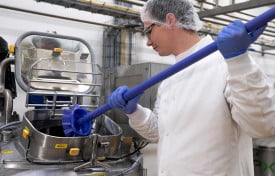Laboratory & QA/QC

- May 12, 2011
Results of a recent survey appearing in the March 2011 issue of Laboratory
- December 10, 2010
At Nelson-Jameson, we try our best to answer our customer questions efficiently and correctly. Below is an important question about Chloride Analyzers which should be considered by our food industry audience.
Customer Question: Why has there been strong demand recently for the Nelson-Jameson M926 Chloride Analyzer?
Nelson-Jameson’s Answer: Salt is the largest source of added sodium in most food products. Of course salt is added as a flavor enhancer and it is also used to lower water activity and create a barrier to dangerous microbes.
Unfortunately salt, and the sodium that comes with it, has been implicated in hypertension leading to cardiovascular disease and strokes. Consumer movements such as the National Salt Reduction Initiative (NSRI), a coalition of public health and food retailing concerns, have responded by recognizing companies that employ effective salt management programs. Many food companies which use salt as a major ingredient including Unilever, Kraft Foods, and Heinz have acknowledged NSRI and are committed to following best practices for responsible salt reduction in their products. Acting on this mandate is also necessary for them to avoid lost market share among their retail customers.
- September 08, 2010
ISFET (Ion-Sensitive Field-Effect Transistor) pH electrodes have been available for quite some time. Nelson-Jameson customers engaged in Food Processing need to be aware that
- March 25, 2010
Imagine a food processing plant without water. Sure there are some that are going as dry as possible to avoid microbiological problems, but for most water plays multiple roles in the manufacturing process. Well or city water for potable and non potable streams, make-up water for reconstituting ingredients, cooling water for heat exchangers, condensate (cow) water for soft rinse applications, water carrying permeate from UF units, water for cleaning chemicals and equipment rinses, effluent water to carry waste to treatment plants, laboratory water purified for various tests, potable water for personnel use. You get the picture – water is everywhere in a production operation.
Depending on use, however, each of these “waters” must have certain qualities.
- Is potable water chlorinated?
- Is the coliform count acceptable?
- Does it have heavy metals like copper or iron?
- Is the hardness softened for cleaning detergents?
- Is permeate clear indicating good UF performance?
- What is the conductivity of laboratory water or cow water?
- Are cleaning solutions sufficiently concentrated, acid, alkaline, or do sanitizing rinses have sufficient strength?
- What is the total solids, BOD, or COD of effluent?
These are just some of the variables which must be monitored when using water effectively in a processing plant.






